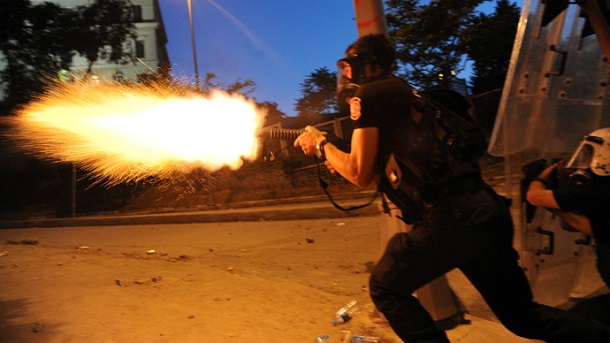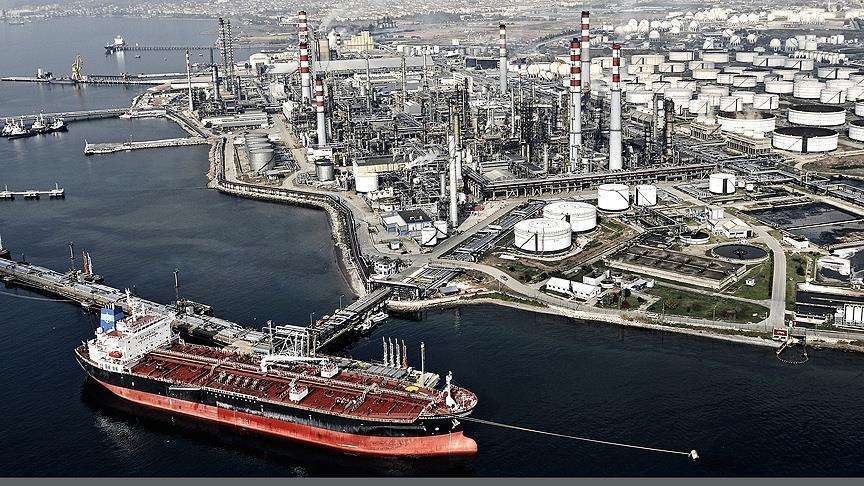Direct Fire to People:Human Rights Watch warned that Turkey about unlawful tear gas fire / Breaking News
Turkish police fired teargas canisters at close range and directly at people during the Gezi Park protests causing serious injuries, says a report by the Human Rights Watch.
Those hit by Turkish police canisters lost eyes and received life threatening skull fractures.
The Turkish authorities “should immediately issue improved guidelines on when and how teargas may be used that included a prohibition on firing teargas canisters in confined areas or directly at people,” Human Rights Watch (HRW) said.
The report titled “Turkey: End Incorrect, Unlawful Use of Teargas,” which has been published on the group’s website, also calls to “strictly enforce” such policies, and hold non-compliant police officers accountable.
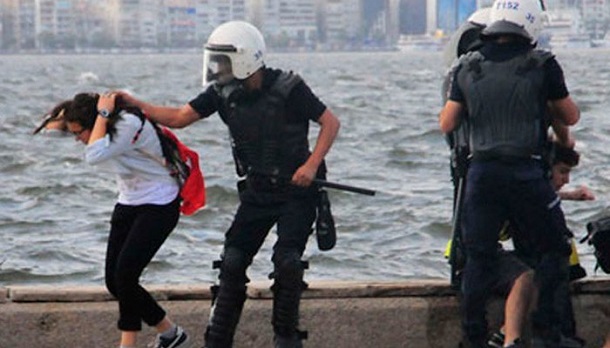 “Teargas canisters can inflict serious ‒ even life threatening ‒ wounds when fired directly at demonstrators, and that happened over and over again at Gezi Park,” said Emma Sinclair-Webb, senior Turkey researcher at Human Rights Watch. “The police and their commanders who used these canisters in such an irresponsible way should be held to account for inflicting unnecessary harm and endangering lives.”
“Teargas canisters can inflict serious ‒ even life threatening ‒ wounds when fired directly at demonstrators, and that happened over and over again at Gezi Park,” said Emma Sinclair-Webb, senior Turkey researcher at Human Rights Watch. “The police and their commanders who used these canisters in such an irresponsible way should be held to account for inflicting unnecessary harm and endangering lives.”
At least 11 people lost an eye after being hit by a teargas canister or a plastic bullet in Turkey up to June 27, says the statement by the Medical Association quoted in the report. Dozens of others received serious head or upper body injuries.
Interviews of victims, witnesses, lawyers, and medical personnel cited in the report suggest that such injuries were caused by police firing tear gas from launchers directly at people, often at close range. The “scale and consistency” of such accounts point to “a clear pattern of misuse of teargas by Turkey’s police force,” HRW states.
Ten accounts of victims who were seriously injured in police tear gas attacks have been documented in the report. Those include a university lecturer who lost his eye as he was walking down the street in Istanbul’s rioting Besiktas district; a long time Taksim square protester who got an 8 centimeter skull fracture and a psychological trauma; a woman taking part in a peaceful sit-in protest who was shot unconscious, had her skull fractured, and was held in an induced coma for 24 days after; as well as a 14-year-old boy apparently caught in close-range police fire near his family home, who suffered from intracranial bleeding and has remained in critical condition for over four weeks.
Turkey Gezi Park Riot:Turkish police are systematically and deliberately shoot protesters
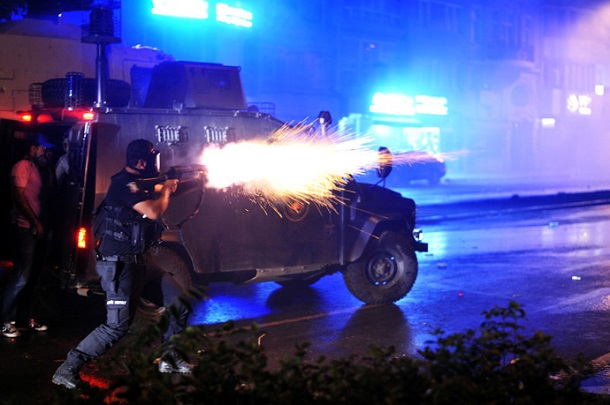
Burak Unveren, 31, who lost his eye in Besiktas on June 1 after being fired at by a police officer some 40 meters away, told HRW he was “almost sure that this act of violence was deliberate.” The police fired tear gas canisters horizontally, rather than trying to launch them at a 45 degree angle, he said. While in hospital, he also met several people “shot in their faces in the same way.”
“Shooting in this way directly at people is a systematic policy of the Turkish police,” Unveren believes.
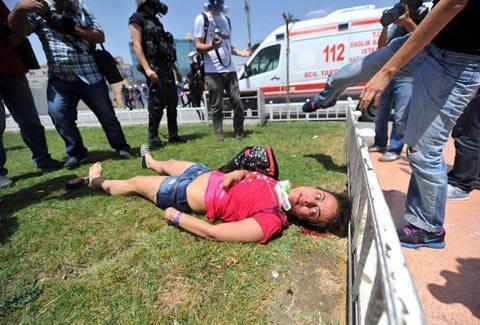 Okan Gocer, 23, who was taking part in a peaceful June 1 protest several hundred meters from Taksim Square, said he was telling people to stay and not to be intimidated by a heavy police presence, when a tear gas attack was launched without warning.
Okan Gocer, 23, who was taking part in a peaceful June 1 protest several hundred meters from Taksim Square, said he was telling people to stay and not to be intimidated by a heavy police presence, when a tear gas attack was launched without warning.
“They just popped out. There were no warnings. They just attacked right away. There were many shots ‒ they just opened fire. One of them hit me in the head. I think the police might have targeted me because I encouraged people to stay,” Gocer said.
The teargas canister that struck the protester rendered him unconscious and caused a 7-8 centimeter fracture to his skull. Gocer had to undergo emergency surgery and was kept in an induced coma for more than two weeks. Nearly a month after the incident he said he still struggled with the pain, and that he was no longer a “cheerful” person “full of hope and optimism” that he used to be.
A 14-year-old boy, Berkin Elvan, who sustained serious head injuries and has remained in critical condition for more than four weeks, was not taking part in protests, but got caught in a police attack in Istanbul’s Okmeydani neighborhood on June 16.
According to accounts by family members and friends, the boy went out to buy bread from a nearby bakery when the police started firing rounds of tear gas at the protesters that had gathered in the area.
Turkey Gezi Park Protests:Police shot and punishing demonstrators
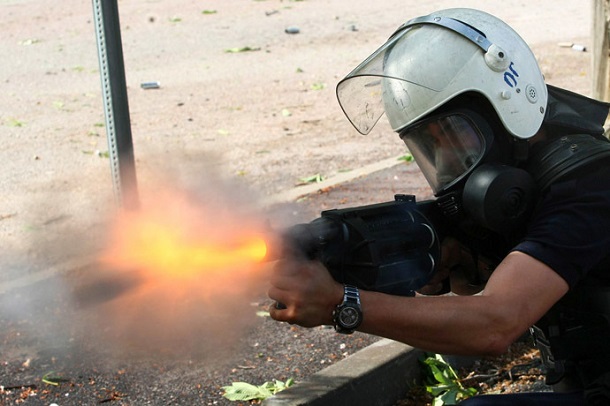
Having seen a large number of injuries resulting from teargas canisters hitting people in the head and upper body, Dr. Hüseyin Demirdiken of the Turkish Medical Association concluded that for the Turkish police “the aim was not only to disperse the crowds, but also to punish.”
Turkish journalist Ahmet Shik, who has been covering the Istanbul protests, is said to have been“deliberately” hit by a tear gas canister in the head, as noted by his friends on Twitter. He said that although some policemen fired tear gas canisters “in a correct way,” most others “fired them directly at the protesters, often from close range.”
Reports said that the Turkish police used 130,000 teargas canisters over three weeks in June. In total, Turkey imported 628 tons of tear gas and pepper spray between 2000 and 2012, Turkish newspaper Sozcu reported, quoting Customs and Trade Minister Hayati Yazici.
On July 16, 2013, the European Court of Human Rights ruled in the case of Abdullah Yaşa and Others v. Turkey that “improper firing of tear gas by Turkish police directly at protestors, injuring a 13 year old, had violated human rights,” and called for stronger safeguards to minimize the risk of death and injury resulting from its use.
[adrotate banner=”64″]

